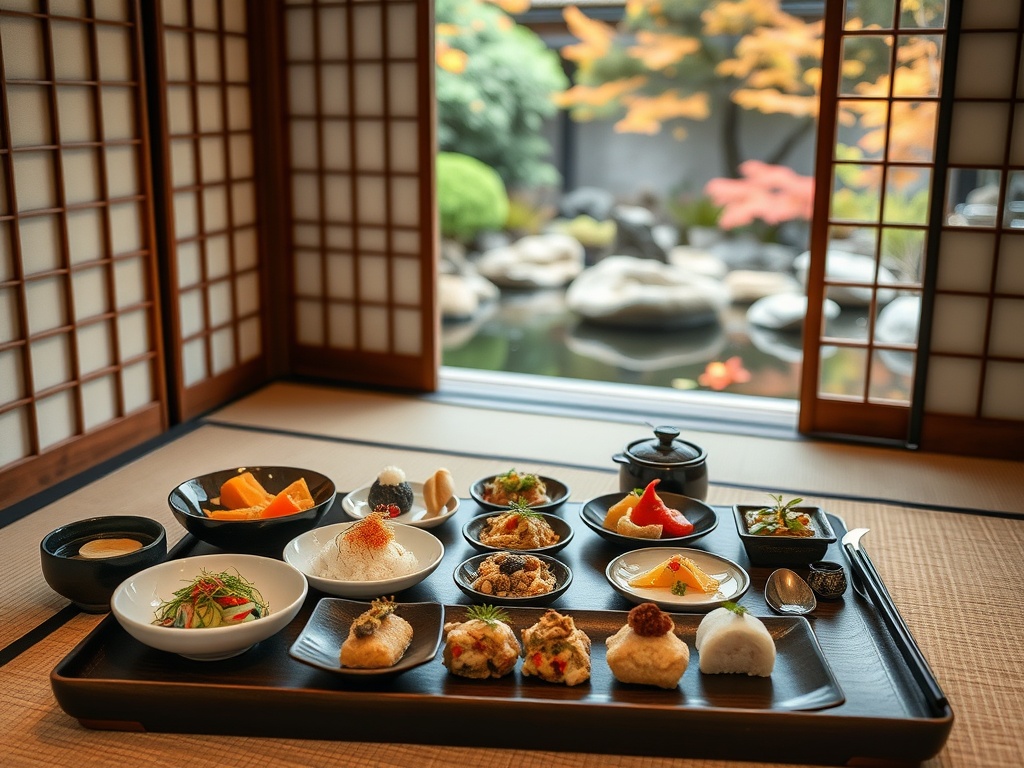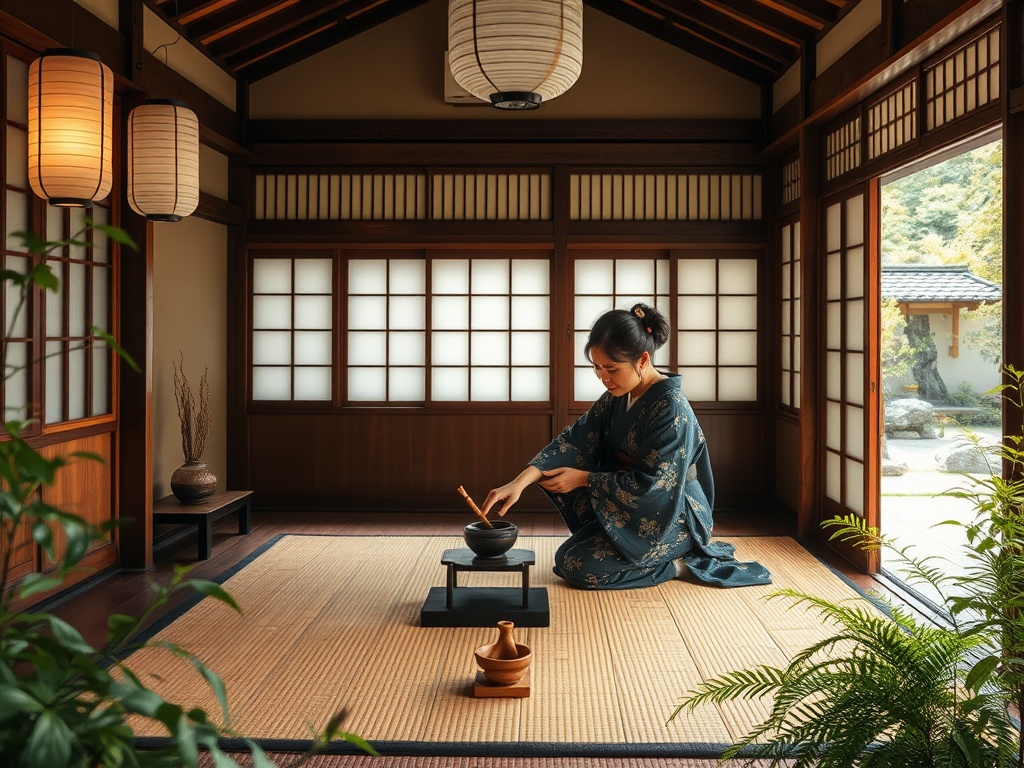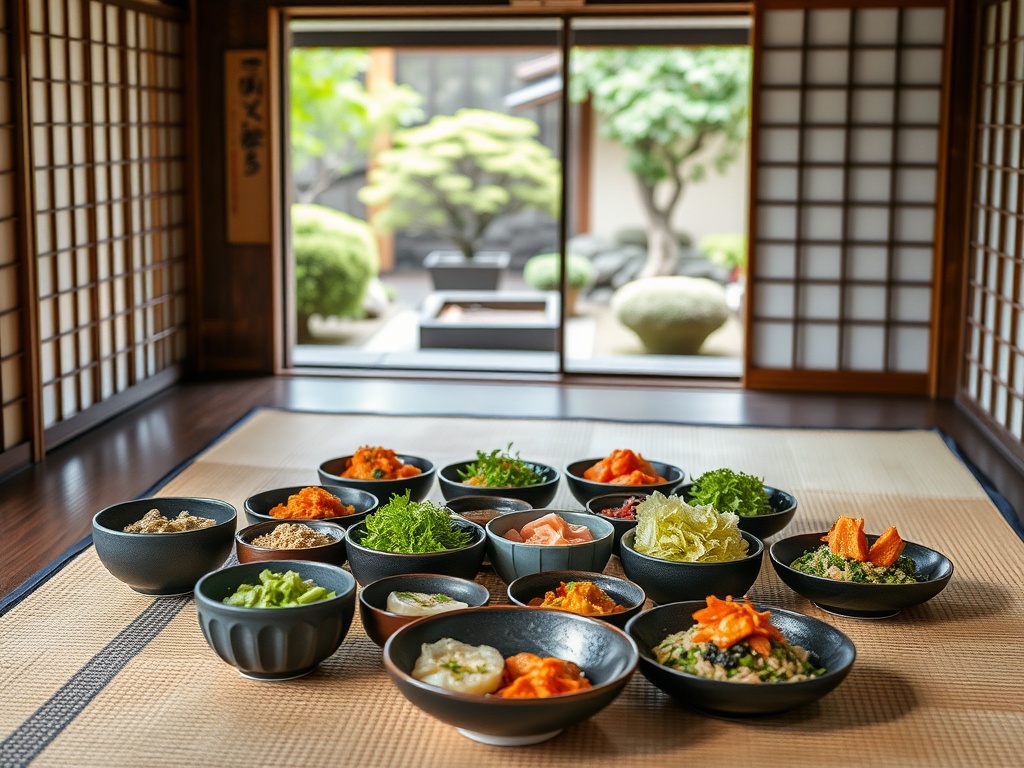Savoring the Seasons: Kyoto’s Kyo-kaiseki Culinary Art
Win a Free Trip to Japan!
Experience cherry blossoms and ancient temples
Kyoto is a city that dances gracefully between its historical elegance and modern vibrancy. The journey through its culinary landscape is nothing short of a magical experience, with Kyo-kaiseki, a traditional multi-course Japanese dinner, as the crown jewel of its gastronomic offerings. Each dish is a work of art, designed to reflect the changing seasons and the natural beauty of Kyoto.
Kyo-kaiseki is much more than a meal; it’s an immersive experience that captures the essence of the seasons. Rooted in Kyoto’s rich cultural heritage, this culinary art combines aesthetics and taste, emphasizing fresh, local ingredients. The chefs create each dish with meticulous attention to detail, ensuring that flavors are harmonious and presentation is breathtaking.
Every element, from the color of the vegetables to the type of dishware used, is chosen to enhance the diner’s experience. This deep respect for nature and seasonality is what makes Kyo-kaiseki a truly unique dining affair.
As you embark on your Kyo-kaiseki journey, you’ll encounter a dazzling array of seasonal ingredients. Here’s a list of some elements that might grace your table:
- Spring: Bamboo shoots, cherry blossoms
- Summer: Ayu (sweetfish), edamame
- Autumn: Matsutake mushrooms, chestnuts
- Winter: Yuzu (citrus), fugu (pufferfish)
These ingredients are not only celebrated for their flavors but also for their symbolic representation of the passing seasons.
Participating in a Kyo-kaiseki dinner is as much about the ritual as it is about the food. Diners are encouraged to appreciate the presentation, savor each bite slowly, and engage with the chef’s artistry. The setting is often serene, with a minimalist aesthetic that directs focus on the meal itself.
Understanding the etiquette, such as the order of dishes and the way to express gratitude to the chef, can enhance your dining experience. Immerse yourself in the calm atmosphere, allowing the delicate flavors and exquisite visuals to transport you to a time where dining was a revered art form.
Tea Time in Tradition: Unraveling the Rituals of Kyoto’s Tea Houses
As you wander through the enchanting streets of Kyoto, you’ll discover that tea is not just a beverage but a profound cultural ritual deeply embedded in the city’s soul. Kyoto’s tea houses offer an intimate glimpse into the world of chanoyu, the traditional Japanese tea ceremony, where every gesture holds centuries of history and meaning. This ritual, much like Kyo-kaiseki, is a dance of precision and beauty—a moment where time seems to pause, allowing you to savor the present.
The tea ceremony, or sado, is a practice that embodies the principles of harmony, respect, purity, and tranquility. In Kyoto, the ceremony is a revered art form, where the preparation and presentation of matcha (powdered green tea) is elevated to a spiritual experience. Each movement is deliberate, from the graceful pouring of water to the gentle whisking of the tea, inviting participants to engage in mindfulness and reflection.
The tea houses of Kyoto are often nestled in serene gardens, providing a perfect backdrop for this meditative experience. As you sit on tatami mats, you are enveloped in an atmosphere of calm, where the only sounds are the soft rustling of kimono fabric and the gentle clinking of tea utensils.
Understanding the elements of the tea ceremony can greatly enhance your visit. Here are some of the key components you will encounter:
- Chawan (Tea Bowl): Each tea bowl is unique, chosen for its aesthetic qualities and suitability for the season.
- Chasen (Tea Whisk): A bamboo whisk used to blend the matcha powder with hot water, creating the perfect frothy consistency.
- Chakin (Linen Cloth): Used to clean the tea bowl, ensuring purity and respect.
- Wagashi (Japanese Sweets): Served before the tea, these sweets balance the bitterness of the matcha and are often crafted to reflect seasonal themes.
When visiting a Kyoto tea house, mindfulness of etiquette can deepen your appreciation of the experience. It is customary to bow when entering the tea room and to express gratitude to the host. Enjoy the tea and sweets slowly, allowing each taste to linger. Remember, the beauty of the tea ceremony lies not only in the tea itself but also in the shared moment of tranquility and connection.
As you partake in this ancient tradition, you’ll find that the tea ceremony is more than just a taste of Kyoto—it’s a window into the heart of Japanese culture, offering a serene escape from the hustle and bustle of modern life.
Temple Cuisine: The Zen of Shojin Ryori in Kyoto’s Monastic Retreats
Nestled amidst the serene landscapes and ancient temples of Kyoto, Shojin Ryori offers a culinary journey that transcends mere sustenance. This traditional form of Buddhist vegetarian cuisine, practiced in Zen monasteries, invites you to explore the philosophy of simplicity, mindfulness, and respect for all living things. As you experience this unique dining tradition, you’ll find that each dish is a meditative experience, crafted to nourish both body and soul.
Shojin Ryori is designed to promote physical health and spiritual enlightenment. The cuisine is rooted in the principles of Buddhism, emphasizing respect for nature and abstaining from meat to avoid taking life. Ingredients are carefully selected to provide balanced nutrition, featuring seasonal vegetables, tofu, seaweed, and grains, each prepared to enhance their natural flavors without artificial enhancements or waste.
In Kyoto’s monastic retreats, dining is an extension of meditation practice. Meals are prepared and consumed in silence, allowing diners to focus on the textures, flavors, and aromas of each bite. This mindful approach encourages deeper appreciation and gratitude for the food, transforming a simple meal into a spiritual experience.
Understanding the staples of Shojin Ryori will enrich your culinary exploration:
- Tofu: A versatile protein source, often grilled or simmered, absorbing the essence of accompanying ingredients.
- Seasonal Vegetables: Fresh, local produce such as daikon, lotus root, and mushrooms, highlighting the changing seasons.
- Seaweed: Provides umami flavor and essential minerals, commonly used in soups and salads.
- Miso: Fermented soybean paste, a staple for soups, adding depth and warmth to the meal.
When visiting Kyoto’s temples, participating in a Shojin Ryori meal can offer a profound cultural insight. Here are some tips to enhance your experience:
- Embrace Minimalism: Appreciate the simplicity and elegance in presentation and flavor.
- Mindful Eating: Engage fully with the meal, savoring each bite without distractions.
- Respectful Silence: Allow the quietude of the temple setting to deepen your connection with the food and your surroundings.
As you immerse yourself in the tranquil world of Shojin Ryori, you’ll find that this ancient culinary tradition offers more than nourishment; it provides a moment of peace and reflection, a chance to connect with the Zen spirit of Kyoto.
Market Meanderings: A Flavorful Journey Through Nishiki Market
Kyoto’s culinary scene is a treasure trove of flavors, where tradition and innovation blend seamlessly. Among the bustling streets and serene temples, Nishiki Market stands as a vibrant epicenter of local gastronomy. Known as ‘Kyoto’s Kitchen,’ this historic market stretches over five city blocks, offering a sensory feast to those who wander through its lively stalls.
As you step into Nishiki Market, the sights and aromas are nothing short of mesmerizing. This bustling marketplace is a microcosm of Kyoto’s diverse food culture, where you can sample an array of local delicacies. From freshly caught seafood to pickled vegetables and sweet treats, every corner presents an opportunity to indulge your taste buds.
The market is not only a place to shop but also an educational experience. Vendors are often eager to share their knowledge, offering insight into the history and preparation of their goods. Whether you’re a seasoned foodie or a curious traveler, the market invites exploration and discovery at every turn.
Embarking on a culinary journey through Nishiki Market, you’ll encounter a myriad of flavors that capture the essence of Kyoto. Here’s a list of some must-try delicacies to savor:
- Nishiki Sushi: Unique sushi made with seasonal ingredients, offering a fresh and authentic taste of Kyoto.
- Yuba: Delicate tofu skin, often served in soups or as a standalone snack.
- Soy Milk Donuts: Delightfully soft and sweet, these donuts are a popular treat among market-goers.
- Kyoto Pickles: Known locally as ‘tsukemono,’ these pickles provide a tangy and refreshing bite.
- Grilled Seafood: Freshly prepared and bursting with flavor, a must for seafood lovers.
To make the most of your visit to Nishiki Market, it’s helpful to be mindful of a few shopping tips and cultural nuances. Firstly, try to visit during weekdays to avoid the weekend crowd, allowing for a more leisurely experience. Sampling is encouraged, so embrace the opportunity to taste different items before making a purchase.
Respectful interaction with vendors is key. A simple bow and a smile go a long way in expressing gratitude. Additionally, while cash is generally preferred, some stalls may accept electronic payments, so it’s wise to have both options available.
As you meander through Nishiki Market, you’ll find that it offers more than a culinary adventure; it’s a journey into the heart of Kyoto’s vibrant food culture, where each bite tells a story of tradition and innovation.
Sweet Journey: Indulging in Kyoto’s Wagashi Confections
Kyoto, a city renowned for its culinary artistry, offers a unique experience for those with a sweet tooth—an indulgent journey through the world of wagashi. These traditional Japanese confections are not just desserts; they are edible masterpieces that capture the essence of Kyoto’s rich cultural heritage and seasonal beauty. Crafted with precision and care, each piece of wagashi tells a story of tradition, craftsmanship, and the delicate balance of flavors.
Wagashi is an art form that reflects the changing seasons and Kyoto’s deep connection to nature. These confections are meticulously handcrafted using natural ingredients like sweet azuki bean paste, rice flour, and seasonal fruits. The designs often mimic the flora and fauna of the region, making each piece a visual delight as well as a tasty treat. The process of creating wagashi is a labor of love, where artisans spend years perfecting their skills to ensure that every detail is flawless.
As you explore Kyoto, you will find wagashi shops that have been family-run for generations, each offering their own unique interpretations of these sweets. Whether it’s the vibrant colors of spring depicted in a sakura (cherry blossom) wagashi or the earthy tones of autumn reflected in a chestnut sweet, each piece is a testament to the artistry and tradition that defines Kyoto.
Embarking on a wagashi journey in Kyoto means encountering a variety of delightful and intricate confections. Here are some must-try wagashi that will tantalize your taste buds:
- Yatsuhashi: A cinnamon-flavored sweet, often filled with red bean paste, and a quintessential Kyoto specialty.
- Namagashi: Soft sweets that are beautifully crafted to represent seasonal motifs, offering a delicate balance of flavors.
- Monaka: Crispy wafers filled with rich bean paste, perfect for those who enjoy a contrast of textures.
- Daifuku: Soft mochi filled with sweet fillings, a beloved treat that is both chewy and satisfying.
To truly appreciate wagashi, it’s worth visiting some of Kyoto’s renowned confectioneries. Many of these shops are located near historic districts or temples, providing an authentic setting for your tasting experience. Look out for shops that offer omotenashi, the Japanese philosophy of exceptional hospitality, ensuring that your visit is as memorable as the sweets themselves.
Whether you are savoring these confections in a traditional tea house or as an on-the-go treat, wagashi offers a sweet escape into the heart of Kyoto’s culinary tradition, making it a must-experience for any traveler with an appreciation for culture and cuisine.
Fushimi’s Finest: Exploring the Sake Breweries of Kyoto
In the heart of Kyoto’s historic landscape lies Fushimi, a district renowned for its rich tradition of sake brewing. Here, the art of sake production has been perfected over centuries, offering a unique glimpse into one of Japan’s most cherished cultural practices. As you wander through Fushimi’s charming streets, the unmistakable aroma of fermenting rice and koji fills the air, inviting you to explore the depths of a beverage that has been integral to Japanese life and celebration.
Fushimi’s sake breweries are a testament to the harmonious blend of time-honored techniques and modern innovations. The pristine waters of the Horikawa River, essential for producing high-quality sake, have attracted brewers to this region for centuries. Each brewery offers a distinct take on sake, balancing traditional methods with contemporary twists to create flavors that are both familiar and new. The experience is not merely about tasting but understanding the intricate process that transforms simple rice into a beverage of profound complexity.
Visiting Fushimi’s sake breweries is akin to stepping into a living museum where each barrel tells a story. Many breweries offer tours that guide you through the brewing process, from steaming the rice to the delicate art of fermentation. These tours often culminate in a tasting session, where you can savor the nuanced flavors of sake varieties ranging from dry and crisp to rich and full-bodied. Engaging with the brewers, who are often keen to share their passion, adds a personal touch to your visit, making it an enriching cultural experience.
To truly appreciate the depth of Fushimi’s sake, pair your tasting with an exploration of local cuisine. Many breweries feature adjacent eateries where expertly crafted dishes complement the unique profiles of the sake. Additionally, consider visiting during the sake festivals that celebrate the brewing season, offering a vibrant atmosphere filled with traditional music, dance, and, of course, ample opportunities to enjoy sake. This immersive experience allows you to engage with Kyoto’s cultural tapestry in a way that is both enjoyable and enlightening.
Street Food Extravaganza: Discovering Kyoto’s Yatai Delights
In the heart of Kyoto, beyond the serene temples and elegant gardens, a vibrant street food culture awaits to tantalize your senses. Yatai, or street stalls, offer a delightful array of quick bites that are as diverse as they are delicious. Strolling through Kyoto’s bustling streets, you can savor the aromatic symphony of sizzling meats, sweet confections, and savory treats that showcase the inventive spirit of Japanese street food.
Kyoto’s yatai are a testament to the city’s ability to blend tradition with modernity. Here, you can indulge in timeless favorites that have been perfected over generations, alongside contemporary twists that surprise and delight. The street food scene in Kyoto echoes the city’s culinary philosophy—respect for seasonal ingredients and a passion for flavor.
- Takoyaki: These savory octopus-filled dough balls are a staple of Kyoto’s street food, characterized by their crispy exterior and soft, flavorful center, often topped with bonito flakes and tangy sauce.
- Yaki Imo: Perfect for cooler evenings, these roasted sweet potatoes are beloved for their naturally sweet taste, offering a comforting bite as you explore the city.
- Kushikatsu: Skewered and fried to perfection, these bite-sized delights are a must-try, with options ranging from juicy meats to fresh vegetables.
- Matcha Soft Serve: Embrace Kyoto’s tea heritage with this creamy, green tea-flavored ice cream—a refreshing treat amidst your culinary adventure.
To truly immerse yourself in the street food culture, knowing where to find Kyoto’s best yatai is key. These lively stalls are often found in bustling districts, each offering its own unique flavor of local life and cuisine.
| Location | Highlights |
|---|---|
| Nishiki Market | A bustling hub of flavors, offering a diverse range of street food and local delicacies. |
| Shijo Dori | Perfect for an evening stroll, this area is lined with yatai offering everything from savory to sweet treats. |
| Gion District | Known for its traditional ambiance, enjoy street food with a side of cultural history. |
Whether you’re a first-time visitor or a seasoned traveler, Kyoto’s street food scene offers an unforgettable taste of the city’s culinary diversity. Each bite is a step into the rich tapestry of flavors that make Kyoto a culinary paradise.
Dining Like a Samurai: The Legacy of Kyoto’s Traditional Izakayas
Kyoto, Japan’s ancient capital, is a city where history whispers through the cobblestone streets and culinary traditions are savored with every bite. To truly experience the essence of this captivating city, one must dive into its vibrant izakaya culture. These traditional Japanese pubs offer more than just food and drink; they are gateways to the past, where the spirit of the samurai lingers in every corner.
When you enter a Kyoto izakaya, you are stepping into a world that has remained largely unchanged for centuries. The warm glow of paper lanterns, the gentle hum of conversation, and the welcoming aroma of grilled delicacies transport you to a time when samurai roamed these lands. Each izakaya tells a story, with interiors that often feature tatami mats and traditional decor, creating an ambiance that is both authentic and inviting. Diners can expect an intimate setting where the focus is on savoring the moment and the delectable offerings.
The culinary offerings in Kyoto’s izakayas are a testament to the city’s rich gastronomic heritage. Here, you can indulge in dishes that echo the fortitude and elegance of the samurai. From robust yakitori skewers to intricately prepared nimono (simmered dishes), each plate is a tribute to the art of Japanese cuisine. Izakayas often feature fresh, seasonal ingredients, with menus that change to reflect the bounty of each season, ensuring that each visit is a unique culinary journey.
Pair these dishes with a selection of sake or local beer, and you’ll find yourself embarking on a flavorful adventure that pays homage to Kyoto’s historical roots. The experience is not just about the food, but also about the camaraderie and the shared enjoyment of a meal, much like the gatherings of samurai in times past.



